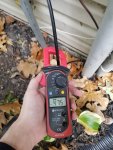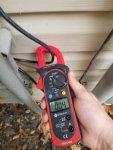jhardy13
Member
- Location
- Joplin Missouri
- Occupation
- Industrial Engineering student
Okay, I am about ready to give up on this and just move across town. I don't have the free time to or will to continue pursuing the root cause of this. This might be my last question here unless something obvious comes up.
I found that we have ac current on our coax cables at the service entrance. We have network issues all the time even though our speeds are good and signal levels are in spec on the modem home page. Could this be related? Roughly .3amps to 1amp on coax and the home is drawing about 6amps total. The current is only on the coax cable on the ISP side of the ground bond and the current is also on the ground bond. I've read this can indicate a loose neutral, but all of our connections have been checked. Could it be a neighbor with a loose neutral and some of their current is returning on our coax cables to our neutral? Attaching some photos below. One above the ground bond and one below. The one with the current is going to the street.
I found that we have ac current on our coax cables at the service entrance. We have network issues all the time even though our speeds are good and signal levels are in spec on the modem home page. Could this be related? Roughly .3amps to 1amp on coax and the home is drawing about 6amps total. The current is only on the coax cable on the ISP side of the ground bond and the current is also on the ground bond. I've read this can indicate a loose neutral, but all of our connections have been checked. Could it be a neighbor with a loose neutral and some of their current is returning on our coax cables to our neutral? Attaching some photos below. One above the ground bond and one below. The one with the current is going to the street.



